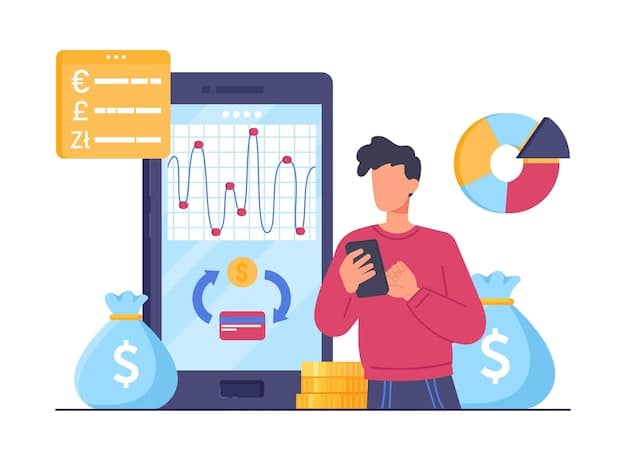Stop Living Paycheck to Paycheck: 5 Immediate Relief Tips

Stop living paycheck to paycheck by implementing straightforward personal finance strategies. These immediate relief tips can increase financial stability and security for a brighter financial future.
Are you tired of the constant stress that comes with living paycheck to paycheck? It’s a common situation, but it doesn’t have to be your reality. There are practical steps you can take to regain control of your finances and build a more secure future, starting today.
Understand Your Current Financial Situation
The first crucial step to escaping the paycheck-to-paycheck cycle is to truly understand where your money is going. This involves taking a close look at your income, expenses, and debts. Without a clear picture of your finances, it’s impossible to make informed decisions about where to save and how to budget.
Many people avoid this step because it can be uncomfortable to face financial realities. However, this knowledge is power, and it sets the foundation for future financial success.
Track Income and Expenses
Start by documenting every dollar that comes in and every dollar that goes out. Use a spreadsheet, budgeting app, or even a simple notebook to record your income sources and all your expenses, no matter how small. Categorize your spending to see where your money is being allocated. This will allow you to identify areas where you can potentially cut back.
Calculate Your Net Worth
Your net worth is a snapshot of your current financial health. Calculate it by subtracting your total liabilities (debts) from your total assets (what you own, such as savings accounts, investments, and property). This gives you a clear indication of your financial standing and highlights areas that need improvement.
- Review bank statements: Go through your bank statements to identify recurring expenses and potential overspending.
- Analyze spending habits: Reflect on your spending habits and identify areas where your money could be better spent.
- Set realistic goals: Based on your financial analysis, set achievable goals for saving and debt reduction.
Understanding your current financial situation is not just about knowing the numbers; it’s about developing a deeper awareness of your relationship with money. This self-assessment is essential for building long-term financial stability.

Create a Realistic Budget
Once you understand your financial situation, the next step is to create a budget. A budget is a plan for how you will spend your money, ensuring you cover essential expenses and allocate funds towards your financial goals. A well-structured budget provides a roadmap for achieving financial stability and preventing overspending.
Creating a budget isn’t about restricting yourself; it’s about making conscious choices about where your money goes. This prevents impulsive spending and ensures you meet your financial obligations.
The 50/30/20 Rule
One popular budgeting method is the 50/30/20 rule. This divides your after-tax income into three categories: 50% for needs, 30% for wants, and 20% for savings and debt repayment. The “needs” category includes essential expenses like housing, food, and transportation. “Wants” are non-essential expenses like dining out, entertainment, and hobbies. The “savings and debt repayment” category is dedicated to building your savings and paying off debts.
Zero-Based Budgeting
Another effective budgeting method is zero-based budgeting. This involves allocating every dollar you earn to a specific purpose, ensuring that your income minus your expenses equals zero. This method requires you to plan every expense in detail, making you more aware of your spending habits.
- Identify your income: Calculate your monthly income after taxes.
- List your expenses: List all your essential and non-essential expenses.
- Allocate funds: Assign a specific amount of money to each expense category.
- Review and adjust: Regularly review your budget and make adjustments as needed.
Build an Emergency Fund
An emergency fund is a savings account specifically for unexpected expenses. It’s your financial safety net, providing you with a buffer during job loss, medical emergencies, or unexpected home repairs. Having an emergency fund can prevent you from relying on credit cards or loans, which can lead to a cycle of debt.
Ideally, your emergency fund should cover three to six months’ worth of living expenses. This may seem like a daunting amount, but starting small and consistently saving can help you reach your goal.
Start Small and Automate Savings
Begin by setting a small savings goal, such as $500 or $1,000. Once you reach this initial goal, gradually increase it over time. Automate your savings by setting up regular transfers from your checking account to your emergency fund. This ensures consistent savings without requiring active effort.
Cut Expenses to Increase Savings
Identify areas in your budget where you can cut back on spending. Even small reductions can add up over time. Consider reducing dining out, entertainment, or subscription services. Redirect these savings towards your emergency fund.
- Open a high-yield savings account: Look for a savings account that offers a competitive interest rate.
- Set up automatic transfers: Schedule regular transfers from your checking account to your savings account.
- Treat it as non-negotiable: Prioritize your emergency fund savings and avoid dipping into it unless absolutely necessary.
Building an emergency fund provides peace of mind and financial security. It protects you from unexpected financial setbacks and prevents you from accumulating debt.
Reduce Debt
Debt can be a major obstacle to financial freedom. High-interest debt, such as credit card debt, can quickly accumulate and make it challenging to break the paycheck-to-paycheck cycle. Reducing debt frees up cash flow and improves your overall financial health.
There are several strategies for reducing debt, including the debt snowball method and the debt avalanche method. Choose the method that best suits your financial situation and preferences.
Debt Snowball Method
The debt snowball method involves paying off your debts in order from smallest to largest, regardless of interest rate. This method provides quick wins, which can be highly motivating. As you pay off smaller debts, you gain momentum and feel more confident in your ability to tackle larger debts.
Debt Avalanche Method
The debt avalanche method involves paying off your debts in order from highest to lowest interest rate. This method saves you the most money in interest payments over time. While it may take longer to see initial results, it is the most financially efficient approach.
- List your debts: List all your debts, including balances, interest rates, and minimum payments.
- Choose a method: Decide whether to use the debt snowball or debt avalanche method.
- Make extra payments: Allocate extra funds towards your debt repayment each month.
- Negotiate interest rates: Contact your creditors to negotiate lower interest rates.

Increase Income
While reducing expenses and managing debt are important, increasing your income can significantly accelerate your progress towards financial freedom. More income provides you with more resources to save, invest, and achieve your financial goals.
There are numerous ways to increase your income, including asking for a raise, starting a side hustle, or pursuing additional education to enhance your skills.
Ask for a Raise
Prepare a well-researched case for why you deserve a raise. Highlight your accomplishments, contributions to the company, and market value for your position. Practice your negotiation skills and be confident in your worth.
Start a Side Hustle
A side hustle is a part-time job or business that supplements your primary income. Consider your skills, interests, and available time when choosing a side hustle. Options include freelancing, driving for a ride-sharing service, or selling products online.
- Identify your skills: Determine your strengths and how they can be monetized.
- Explore opportunities: Research potential side hustle ideas and assess their profitability.
- Set realistic goals: Establish achievable income goals for your side hustle.
Increasing your income can transform your financial situation, providing you with more opportunities to save, invest, and achieve your financial goals. It empowers you to break free from the paycheck-to-paycheck cycle and build a more secure future.
| Key Point | Brief Description |
|---|---|
| 📊 Budgeting | Track income and expenses to understand where your money goes. |
| 💰 Emergency Fund | Build a safety net for unexpected expenses to avoid debt. |
| 📉 Debt Reduction | Prioritize paying off high-interest debts to free up cash flow. |
| 📈 Income Boost | Explore options like raises and side hustles to increase your earnings. |
Frequently Asked Questions (FAQs)
▼
Start by using a budgeting app, spreadsheet, or notebook to record all your income and expenses. Categorize your spending to identify areas where you can cut back.
▼
The 50/30/20 rule allocates 50% of your after-tax income to needs, 30% to wants, and 20% to savings and debt repayment.
▼
Ideally, your emergency fund should cover three to six months’ worth of living expenses to provide a financial safety net.
▼
The debt snowball method involves paying off your debts in order from smallest to largest, regardless of interest rate, for quick wins.
▼
Increase your income by asking for a raise at your current job or starting a side hustle to supplement your primary income.
Conclusion
Breaking free from the paycheck-to-paycheck cycle is achievable with these five **personal finance** tips. By implementing these immediate relief strategies, you can improve your financial stability, reduce stress, and build a brighter future. Start today and take control of your finances.





